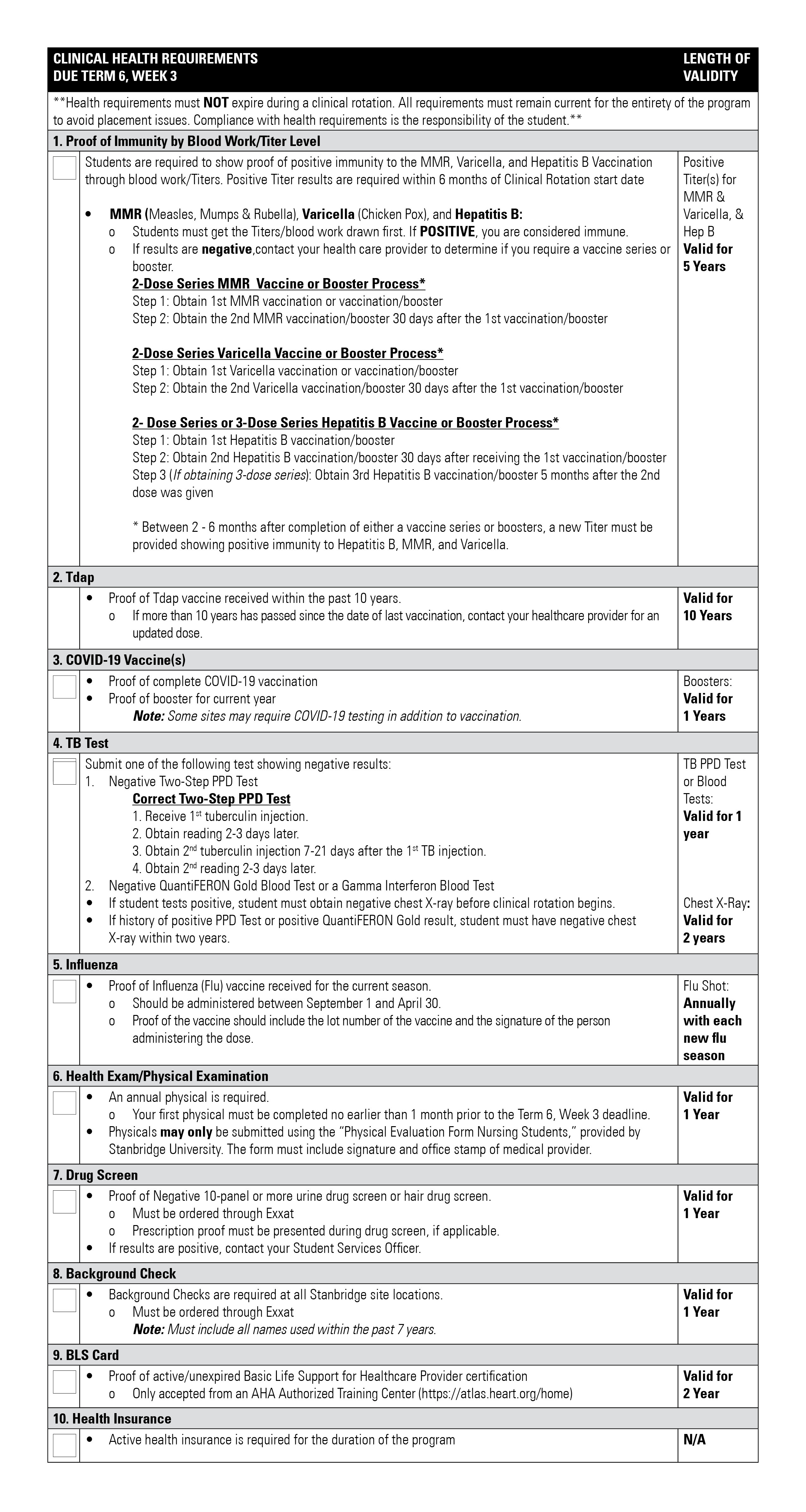BSN Additional Policies
In addition to meeting the requirements for admission as stated above under Admission Policies, students in the Bachelor of Science in Nursing (BSN) program must provide the following:
Health Requirements
Please see the list below for mandatory vaccinations and other health requirements. These must be completed, submitted for compliance, and approved by Term 6, Week 3 to ensure processing and placement at a clinical facility. It’s important to note that certain items on the list, such as obtaining results and/or necessary boosters, may require additional time. Therefore, students should begin the process well in advance of the Term 6, Week 3 deadline.
Please note, clinical partners may change immunization and health requirements with no advanced notice, for any reason at any time. You will be notified accordingly as soon as the program becomes aware of any changes.
 BSN Dress Code
BSN Dress Code
Students are expected to comply with the dress code as outlined below. Students who do not comply with the dress code will be given a Notice of Deficiency. In clinical and laboratory, students who are noncompliant with the dress code will be requested to leave, incur an absence, and given a Notice of Deficiency.
- A student ID badge must be worn at all times above the waist and visible when wearing a sweater. Students will not be allowed to take an assessment without a student ID badge. An assessment is defined as a quiz, examination, or ATI assessment.
- All students must be neat and well groomed. Students should bathe daily and use deodorant. Students should have no offensive body odor or cigarette smell.
- Clothing must fit properly and not be tight-fitting. Skinny jeans/pants or tights/leggings are not permitted.
- On campus uniform includes blue polo shirt with the Stanbridge logo; plain white or black under shirt or white “sleeves” to cover tattoos; plain black scrub pants without print , colorful embroideries, or borders; white or black socks or neutral nylons; and white or black shoes.
- All pants must cover the entire length of the legs. No ankles or skin should show between the hem of the pants and the socks.
o Shoes must be closed-toed, closed-heeled, and low-heeled. Crocs are not allowed.
o Shoes must be without print except for the shoe logo.
o Shoes must be clean with only white or black shoelaces. - Clinical and laboratory uniform includes blue scrubs with the Stanbridge logo, plain white or black under shirt or “sleeves” to cover tattoos, white or black socks or neutral nylons, and white or black shoes. The laboratory uniform is worn for skills and simulation lab.
o Pregnant students must adopt a similar maternity scrub uniform.
o Uniform must be neat and pressed.
o Only clean, solid white or black, closed-toed, closed-heeled, and low-heeled shoes with non-skid soles and white or black vinyl or leather top is acceptable. Shoe logo and shoelaces, if present, must be white or black. Crocs are not allowed.
o Stethoscope, penlight, bandage scissors, watch with second hand, calculator, black or blue pen, and paper are part of the clinical uniform. A “fanny pack” or “apron” may be worn over the uniform to increase the number of pockets.
o Sweaters must be solid color (only black, grey, blue, or white) without print except for the Stanbridge logo.
o Sweaters in clinical may not have a hood.
o A hood on campus may not be worn. - No hats or scarves are permitted.
- Hair must be pulled back out of the face and off the shoulders.
o In theory courses, hair in a ponytail is acceptable but must be neatly tied without loose hair.
o In clinical or laboratory, hair must be pulled back out of the face and in a neat bun (not on top of the head nor the back of the neck) without loose hair.
o Hair color must be of a natural color. Faddish or unnatural colors or styles are not permitted. - Facial hair must be neatly trimmed to a maximum length of ½ inch to permit proper fit of personal protective equipment as recommended by the Centers for Disease Control. Facial hair must not be of a faddish or unusual appearance.
- Gum chewing is not allowed in the classroom, lab, or clinical facility.
- Makeup must be suitable. Exaggerated or extreme false eyelashes or extensions are not permitted in the clinical, laboratory, or simulation area. Eyelashes must look natural.
- Perfume, cologne or after-shave is not permitted.
- New tattoos and piercings are discouraged while in school due to increased risk of infection and the ability to comply with clinical site policy.
o Tattoos cannot be visible. Plain white or black under shirt or “sleeves” must be worn to cover the tattoos.
o Except for pierced ears, body piercings with jewelry (brow, nose, tongue, and/or lip) are not allowed. - Jewelry must be kept to a minimum for safety and to be consistent with professional appearance. Jewelry may include only a watch, wedding ring, engagement ring, and small-post earrings if ears are pierced (only one pair of post earrings).
- Nails must be clean, short, and neatly trimmed. Only clear nail polish is permitted. Artificial nails and nail wraps or extenders are not permitted.